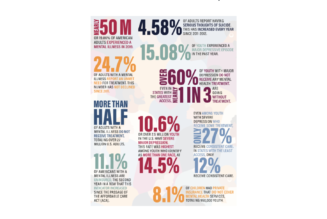Experts such as floodplain managers, risk management officials and climate scientists have complained for years that FEMA has failed to consider those climate-driven changes and that the agency underestimates even the current flood risks because of long delays in updating its maps.
“We’re trying to democratize this data so that everyone has the same set to be able to make decisions with,” said Matthew Eby, First Street’s executive director.
Using its flood-risk scores, First Street found that far more U.S. homes — an estimated 14.6 million — face flooding conditions on par with those in FEMA’s 100-year floodplain. In contrast, FEMA’s maps classify 8.7 million homes as carrying substantial risk.
The true figure climbs to 16.2 million homes by 2050 when the effects of climate change are included, according to First Street’s modeling.
First Street, which built its models in cooperation with advisers and partners from University of Pennsylvania, Massachusetts Institute of Technology, Johns Hopkins University and consulting firms like Rhodium Group and IBM, is among a raft of groups aiming to analyze how climate change will affect communities. The foundation also plans to sell bulk data sets to companies for more complex analysis.
Mapping the areas at risk of flooding has long been a political minefield. Local governments and property owners worry about new maps incorporating them in at-risk zones, since the designation can lower property values and sap tax revenues. FEMA delayed its Risk Rating 2.0 program, which promised more accurate flood mapping, by one year until October 2021 as concerns mounted that flood insurance premiums would spike.
Yet FEMA has faced criticism for years from climate experts that it underestimates flood risk. The agency doesn’t predict how climate change will alter flood patterns, and it hasn’t updated many maps for decades because of lackluster federal funding.
But lenders, banks and real estate investment firms are expecting the risks to continue climbing, and many have bought boutique flood risk products to guide their portfolios. New research published earlier this month by Jesse Keenan, an associate professor at Tulane University, and Harvard University doctoral student Jacob Bradt indicated that lenders appeared to be selling the mortgages on properties with the highest flood risks to Fannie Mae and Freddie Mac, the government-sponsored enterprises that back about half of the U.S. mortgage market, in order to move climate-exposed loans off their books.
Services documenting the property-by-property threats are out of reach for most Americans. Data are opaque for home buyers — 21 states have no requirements for sellers to disclose flood risk, while rules vary among the rest, according to the environmental advocacy group Natural Resources Defense Council.
While generally perceived as a good-faith attempt to fill in the market information gaps, the First Street’s efforts have nonetheless prompted some criticism and cautionary notes. For example, the change could devastate the value of properties owned by people of color, especially Black Americans whose ancestors were forced into less valuable lowland areas after the Civil War and were regularly limited to properties in floodplains through racist lending and zoning practices.
“It will disproportionately affect African Americans or other minority groups who live in communities that are set up to not be able to appreciably build equity,” said Tina Johnson, director of the National Black Environmental Justice Network. “It will advantage developers or young white people who can get their parents to help.”
Those types of concerns are one reason why the Union of Concerned Scientists decided against pursuing property-level evaluations when it researched flood risk with databases provided by online real estate database company Zillow in 2018, said Rachel Cleetus, the organization’s clean energy and climate policy director.
“A lot of people own homes that will now be revealed are exposed to be at risk. The question is where does that leave some of those homeowners?” she said. “It’s important to have science-based information out there and it should be available broadly so people can use it, but it’s so far from sufficient.”
Cleetus also said complications assessing elements like tidal behavior, the effects from human-built structures such as levees, and practices for managing stormwater left UCS believing that its findings weren’t accurate enough to predict the risks for individual properties.
That’s why one of First Street’s innovations that led to its expansive list of flood-prone properties is perhaps its most controversial. The effect of rainfall, especially inland, has proven extremely challenging to measure on the local level, said Keenan, the Tulane professor.
“That human component of it is less predictable and has a lot more complexity,” he said. “The downside is you may miscommunicate that confidence to some people and that may communicate the wrong signal to the market.”
First Street used many data sources to determine local variations. For example, the researchers relied on the U.S. Army Corps of Engineers’ national levee database — comprising roughly 30 percent of U.S. levees — and leaned on modeling, news articles, Corps’ technical manuals and other sources to identify other levees.
It also adjusts models based on national assumptions to “account for built infrastructure that we don’t see” like underwater storm management systems, said Jeremy Porter, First Street’s research and development director, and he said First Street would update its model as new, local information becomes known.
For all their faults, FEMA maps go through a thorough public vetting process that amounts to the “gold standard,” said Chad Berginnis, executive director of the Association of State Flood Plain Managers. Those maps are defensible when businesses or citizens take local governments to court, he said, and are essential tools for understanding where to site infrastructure to help manage flooding.
Overall, homebuyers would likely benefit from knowing their flood risk, Berginnis said. But the challenges of accounting for local conditions could yield imprecise data with negative implications for land-use planning and perceptions of personal flood risk.
“That is an awfully big promise,” Berginnis said. “We’ve just got to be careful where to contextualize that data and what it means.”









